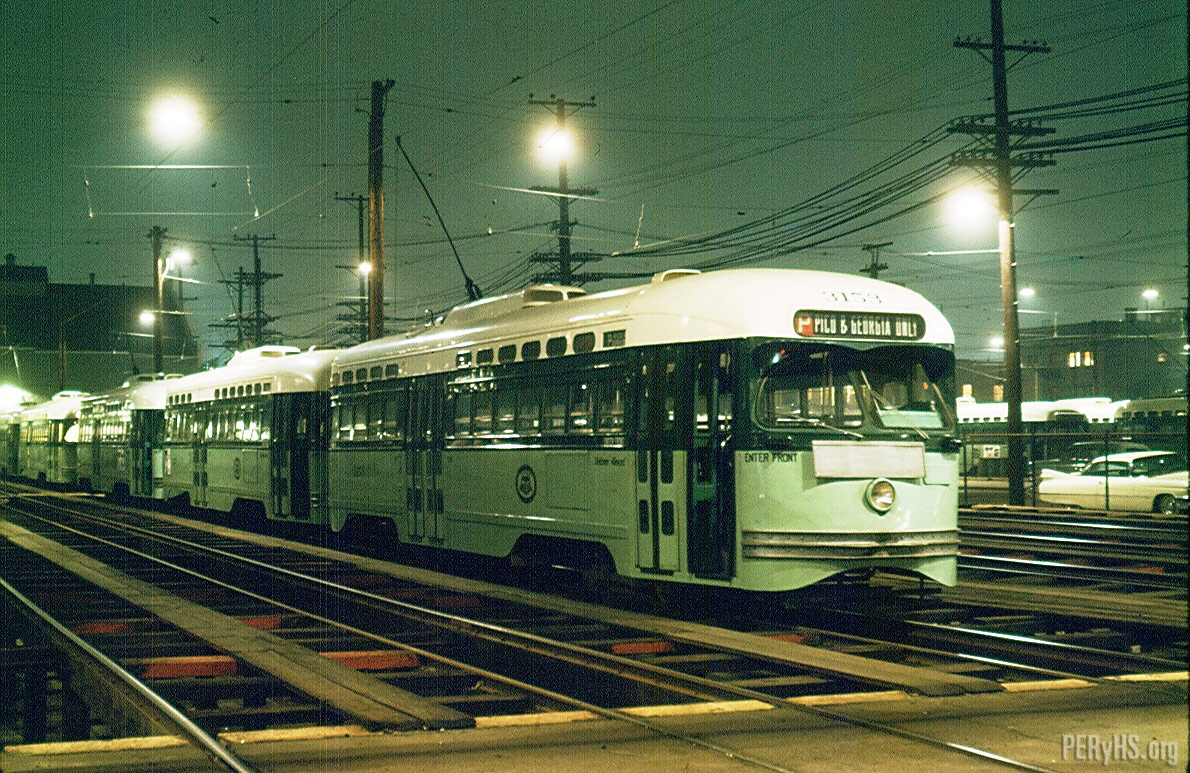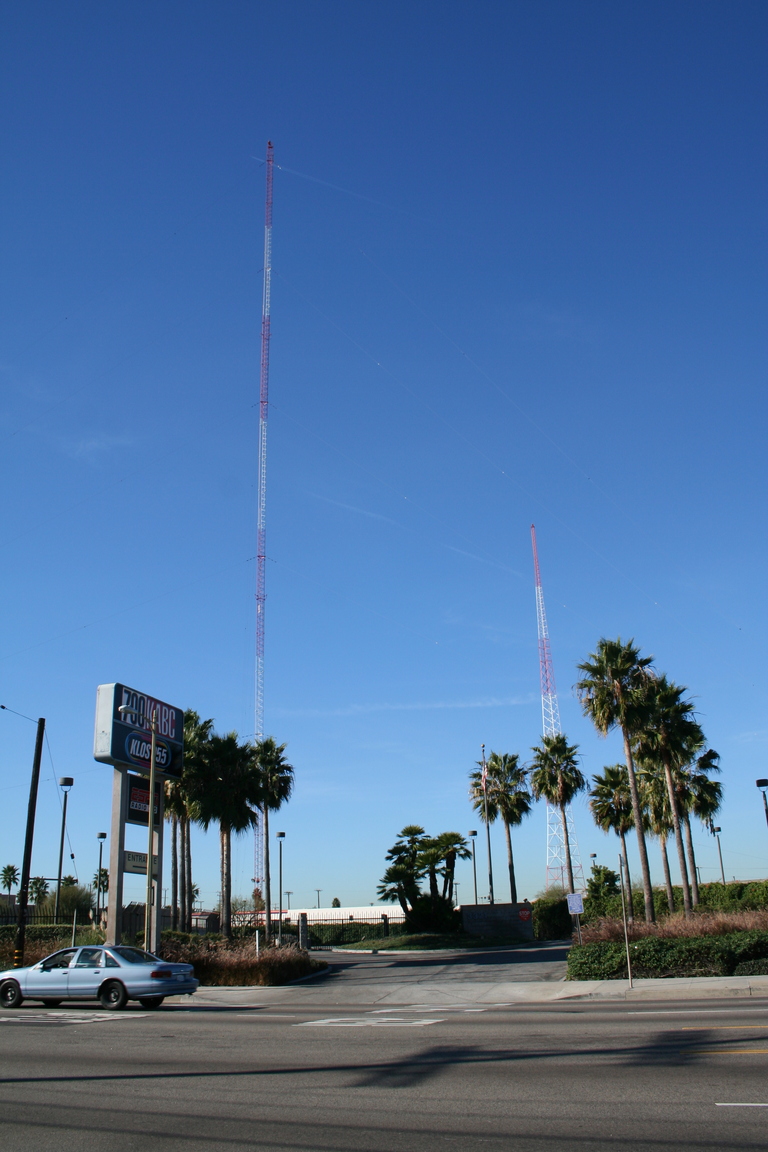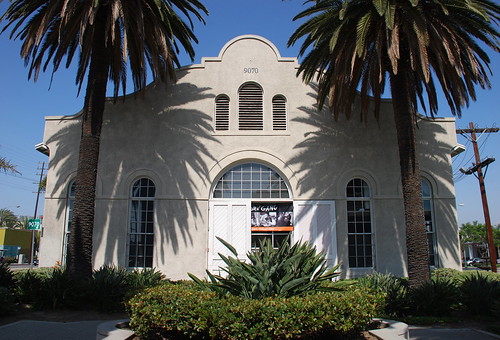This Wednesday, the first phase of the (M) Expo Line will be officially complete with the opening of the long-awaited Farmdale and Culver City stations. To celebrate, The Militant will take you on a tour of the interesting and obscure locales along and near the Expo Line route! He did the same for the Gold Line, uncovering farmer's markets, bird zoos, swallow nests, ginormous sandwiches and even a UFO.
This time around, The Militant shows you an in-depth guide to the line and its surrounding points of interest. Oh sure, others have done something similar and just blog about stuff they see near the stations, and just hop back on the train, but let's face it, no one can offer the historical and cultural knowledge of Los Angeles like The Militant Angeleno can!
Did you know along the Expo Line you can find surviving remnants of the old Pacific Electric Railway? A pretty cool French cafe and bakery? Los Angeles' Belizean district? Read on and re-discover the (M) Expo Line, Militant-style!
7th Street/Metro Center
1. "Metro Center"
For over 20 years, Metro Rail riders have used this station without even knowing why it's called that way. The story really isn't what is here as much as what isn't here - or at least what was supposed to be here. Taking a cue from the Washington D.C. Metro, this station is named for a major transfer station in the system. It was also the intended headquarters of the transit agency -- back then, the Los Angeles County Transportation Commission (one of the forerunner agencies of Metro) was located nearby on 818 W. 7th St. But not much long later, the LACTC merged with the Southern California Rapid Transit District (RTD) to become the Los Angeles County Metropolitan Transportation Authority (a.k.a. Metro) and instead built their own "Metro Center" in 1995 in the form of the Gateway Plaza at Union Station.
Pico/Chick Hearn
2. Convention Center/Site of Georgia St. Streetcar Facility
This site is home of today's Convention Center and what may or may not be tomorrow's Farmers Field, but it was also the Georgia Street Shops - a major streetcar maintenance facility in yesterday's world serving trolleys for the old Los Angeles Railway (Yellow Cars). After the system ended in 1963, the large swath of land became a prime location for the city's Convention Center, once proposed to be located where Dodger Stadium now stands.
 |
| Training ground for future Cable Guys on Washington & Flower. |
Whatup with those utility poles on the corner of Washington and Flower? Is it some sore of abstract art installation? Naw, it's part of Los Angeles Trade Tech College across the street. It's a training ground for lineworkers taking classes or workforce development courses at the college to hone their skills.
23rd Street
4. Site of Washington Park/Chutes Park
The first permanent baseball field in Los Angeles isn't Dodger Stadium, nor was it South Los Angeles' Wrigley Field nor the Fairfax District's Gilmore Field. It was here at Washington Park, located near Washington and Hill, where the Pacific Coast League Los Angeles Angels of Los Angeles played from 1893 to 1925 (the first Washington Park stood from 1893 to 1912; the second was in use from 1912 to 1925. It was torn down in the 1950s. William Wrigley, the team's owner, left Washington Park after he was denied permission to build an underground parking garage. He then moved his Angels to his own Wrigley Field in 1925. Washington Park it was also one of the home venues of the USC Trojans football team before the Coliseum. Adjacent to Washington Park was an amusement park named Chutes Park that stood on the land where the municipal courthouse now stands.
5. Cathedrals at Figueroa & Adams
At the intersection of Figueroa and Adams stands three cathedrals built in the 1920s - Two to Christendom and one to the automobile. On the northwest corner is the Churrigueresque-style (Think Million Dollar Theater) St. Vincent de Paul Catholic Church, built in 1923 and designed by local architect Albert C. Martin, Sr., who also designed today's Los Angeles City Hall. On the southeast corner is the Neo-Romanesque St. John's Episcopal Cathedral (1925; designed by brothers Pierpont and Walter Davis) and on the southwest corner is the Automobile Club of Southern California's Spanish Colonial Revival headquarters, built in 1922 and designed by Summer P. Hunt and Silas R. Burns, who also designed the Southwest Museum.
Jefferson/USC
6. Felix Chevrolet
This long-standing automobile dealership has stood at Figueroa and Jefferson for years, Named after founder Winslow Felix, who originally established his dealership at 12th and Grand in 1921, the famous cartoon cat became part of the branding image of the car lot thanks to Felix's friend, Pat Sullivan, the animator who created the animated feline.
7. Figueroa Tunnel
This short subway tunnel under the Figueroa/Exposition intersection was originally designed to keep the Expo Line immune from street closures resulting from the Los Angeles Marathon, which traditionally ran its course through Figueroa. Since then, the route has drastically changed, but the alignment remains, and all the better - if not for the tunnel, the soon-to-open LACMA Levitated Mass exhibit would have had a difficult time navigating through the Expo light rail catenary power lines. It's the only curved light rail tunnel built for the entire Metro Rail system (the curve near the Gold Line's Memorial Park station was a originally built for Santa Fe Railway trains and adaptively re-used for light rail).
Expo Park/USC
8. USC Widney Alumni House
The original building of one of Los Angeles' most prominent institutions of higher learning (one of the schools which The Militant may or may not have graduated from) stands just yards from the Expo Park/USC station at the relatively new entrance of the University of Southern California, on Exposition Blvd and Pardee Way. The Widney Alumni House is the oldest building on campus, built when the university was founded in 1880. Though it has moved a few times from its original location, it's considered a sacred historical artifact by the university.
10. Exposition Park
It bears mentioning origins of the light rail line's namesake. Built in 1872 as "Agricultural Park" (when much of Los Angeles was farmland), it was given its present name a century ago. Not because it hosted a World's Fair/World Expo (it never did), but because it was part of the late 1800s-early1900s "City Beautiful Movement" urban planning philosophy that created beautified streetscapes and monumental structures in cities across North America. The 160-acre park in its present form began with the establishment of the Museum of Science and Industry (now California ScienCenter), the National Armory, the Natural History Museum and the Rose Garden (at one time the largest rose garden in the world).
11. Los Angeles Memorial Coliseum
You already know this venue as Los Angeles' most revered and historic, yet most neglected, athletic stadia. It's the only building in the world to host The Olympics (twice, in fact), the Super Bowl and The World Series. It's served as home base for the Rams, the Chargers, the Raiders, the Trojans, the Bruins, the Dodgers and even the now-defunct Aztecs and Xtreme. The Lakers, Kings and Clippers also played on the Coliseum grounds. The Militant was personally there to see the world's largest-attended baseball game evar and the Lakers' 2009 championship celebration. This is the home of Los Angeles sports, baby.
It's also hosted everything from religious ceremonies to porno videos, from motocross to concerts (This was where, in 1981, the opening act for The Rolling Stones was boo'ed offstage by the crowd...it was some dude named Prince).
That said, it's in desperate need of new seats.
But from now on, you have absolutely no need to park at or near the Coliseum for any of its events!
Expo/Vermont
12. Masjid Omar ibn Al-Khattab
This masjid (mosque) opened in 1994 but took nearly 20 years to build. In 1977, a Muslim woman who visited her children, both of whom were students at USC, bought the land on the northwest corner of Exposition and Vermont, but became ill and died. Members of the local Islamic community contributed the funds to build a masjid on the land in her memory. It's one of the most visible houses of worship in Los Angeles' Muslim community.
Expo/Western
 |
| Tracey's Belizean Restaurant - one of the local Belize community businesses in the Expo/Western station area. |
Did you know that Los Angeles' Belizean district (not officially designated) is located near the Expo/Western station? Most of the city's 50,000 residents who claim heritage form the Central American country of Belize live in the South Los Angeles area, and the Western Avenue corridor (and nearby vicinity) from Jefferson to Manchester has a number of Belizean restaurants, markets and cultural institutions. Most Belizeans are Garifunas, who are of West African ancestry and are Spanish-speaking, so the historically black, increasingly Latino South Los Angeles has become a place where most in the Belizean community can easily blend in. Want a taste of Belize? Drop by Tracey's Belizean Restaurant on 3810 S. Western, just a half block south of the station!
Expo/Crenshaw
14. West Angeles Cathedral
The large bronze-colored building on the northeast corner of Exposition and Crenshaw is the West Angeles Cathedral, home of the West Angeles Church of God in Christ, one of the largest houses of worship in Los Angeles' African American community. The church was nice enough to lend its parking lot to Metro Rail commuters during weekdays, and the music is known to be pretty kickin' for Sunday services; music legend Stevie Wonder is known to regularly attend and sing there.
15. Earlez Grille
If you haven't had their jumbo turkey hot dogs, veggie chili cheese fries or dessert selections, you probably should. Just feet away from the Expo/Crenshaw station, you might as well just hop off the train and eat here. Earlez Grille should be to the Expo Line what Langer's is to the Red Line.
Farmdale
16. Dorsey High School
This high school was named after Susan Miller Dorsey, the first female superintendent of the LAUSD (circa 1920). Some of its famous alumni include MLB manager Sparky Anderson, U.S. congressmembers Diane Watson and Julian Dixon (who was instrumental in building our Metro system, incidentally), The Beach Boys’ Mike Love, The Fifth Dimension’s (and Solid Gold host) Marilyn McCoo, USC and NFL wide receiver Keyshawn Johnson and California Angels DH Chili Davis, among many others.
17. Rancho Cienega Sports Complex
Located next-door to Dorsey HS is this city-run recreation center, complete with ball fields and a swim stadium. In February 2007, Senator Barack Obama made his first presidential campaign appearance in California here to a modest crowd of about 500 people.
Expo/La Brea
Just a couple blocks southwest of the Expo/La Brea station is The Village Green, a 64-acre condo community (originally called Baldwin Hills Vilage) built in 1941 by architect Reginald Johnson and planner Clarence Stein. Now a National Historic Landmark, this planned residential complex with its emphasis on green and open space at the foot of the Baldwin Hills was regarded as rather innovative when constructed in World War II-era America.
 |
| Normandie Bakery Cafe, a magnifique French bakery/restaurant near the La Brea station. |
Just a short five-block walk west of the La Brea station, on Jefferson and Cochran, is this seemingly random restaurant/bakery/café with outdoor dining right off of Jefferson. Run by French chef Josette LeBlond, the Militant had a pleasant experience having lunch here one day, having himself a nice sammich in the sidewalk patio. He even got a baguette to go. You need to check this place out!
Expo/La Cienega
20. KABC/KLOS/KSPN Radio Facility
The radio towers seen from the station platform is home to one of Los Angeles' longest-running radio broadcasting facilities. Long before it was the home of Ken and Bob Company (EGBOK, y'all) and Mark and Brian (okay, maybe just Brian soon), it started out as KFVF-AM in 1925. Car salesman and local radio mogul Earle C. Anthony, who founded KFI-AM, bought KFVF in 1929 and turned it into a sister station KECA (his initials, you see...). KECA started operations amidst the oilfields on La Cienega and eventually became KABC 790 AM and KABC FM (which became rock radio institution KLOS-FM. The towers are KABC's 5,000 watt transmitter. KLOS' transmitter is high atop Mt. Wilson. The facility is also home to KSPN 710 AM, but their transmitter is located in North Hollywood, next to Los Angeles Valley College.
21. Sees Candies Factory
Canadian confectioner Charle See, along with his wife Florence and his mother Mary, founded Sees Candies on 135 N. Western Avenue in what is now known as Koreatown. Though now headquartered in South San Francisco, the La Cienega facility, built in 1946 and clearly visible from the station, is home to the company's main kitchen and factory. So if you see tanker trucks roll in, remember that they're filled with chocolate (please resist the urge to hijack them). It also has a factory store, which like totally boomed with business on April 28 of this year...Hmmm...wonder why...
Incidentally, Sees Candies is owned by mega-conglomerate Berkshire Hathaway, and the guy who arranged the purchase in 1972 was some dude named Warren Buffet.
21. La Cienega South Design & Arts District
Not to be confused with its long-established sibling to the north on the West Hollywood/Los Angeles border, the corridor of South La Cienega between Venice and Jefferson is emerging with its own spin on arts and furniture design, stemming from its industrial roots on the Culver City/Los Angeles border. Art galleries, design studios and associated shops and cafes have been springing up here in the past 20 or so years. Keep an eye on this place, it's likely to be the next arts district to blow up. And the Expo Line can take you there for their art walk.
22. Expo Bike Path
Remember when we first heard of a bike path along the Expo light rail line? And how we thought it's goon look all pretty and neat and all and look something like the Orange Line's bike path? And remember how we all got pissed when most of it ended up just being a striped bike lane on Exposition itself? Well, take your bike to the west entrance to the station, on the south side of the tracks...there's the bike path you originally thought would get built...all 0.8 miles of it.
Hopefully there will be more bike path for Phase 2, but, c'mon, that's obviously kinda jacked for the South Los Angeles communities, right?
 |
| The old Pacific Electric bridge over the Ballona Creek still stands under its successor, track intact! |
Everyone knows that the Expo Line was once the Pacific Electric Railway's Santa Monica Air Line, and that the century-old tracks and infrastructure was removed to make way for the modern light rail route. But did you know a small piece of the old Red Car line still remains? The old wooden bridge that spans the Ballona Creek is still intact, located directly below the Expo Line's elevated structure.
24. Ballona Creek Bike Path
Definitely more than a measly 0.8 miles, this 6-mile bike path will take you all the way to Playa Del Rey. The Militant has taken it many times before. It's Summer now, so...you know what to do.
 |
| The Hayden Tract's Samitaur Tower welcomes you. |
As your westbound train descends from the elevated structure after the La Cienega station, do look to the left side of the train for a set of architecturally-unique buildings. That's Culver City's Hayden Tract, a collection of offices, art galleries, design firms and entertainment and tech industry studios. What was once Culver City's oldest industrial district, architect Eric Owen Moss and developers Frederick and Laurie Samitaur Smith created the Hayden Tract in 1986 as a redevelopment project and economic development engine fueled by arts and design. The result is buildings known as "The Beehive," "The Stealth" and "The Umbrella," a dance studio known as Conjuntive Points, Moss' own design studio and one of Los Angeles' most innovative design centers.
Culver City
26. Pacific Electric Ivy Substation
Downtown Culver City is already rich in retail and artistic activity, and has a bevy of well-known eateries, like the popular Father's Office. The Militant can cover that in its own post (and kinda already did before). But welcoming people to Downtown Culver City along Venice Blvd, a block from the Culver City station is an appropriate link to the past - the Ivy Substation. The single-story Mission Revival-style structure served as a powerhouse for the Pacific Electric Railway from 1907 to 1953, when the Expo Line's predecessor, the Santa Monica Air Line, ceased operation. Today, it's a 99-seat venue for The Actor's Gang theatre company, renovated in the early 1990s. How interesting that a building originally built for transportation infrastructure was repurposed into a building for the arts, which in turn attract people using the new transportation infrastructure.
Enjoy your complete Phase I Expo Line! The Militant may or may not revisit this tour with a sequel post in 2016 covering the other half of the line!















11 comments:
Hey Militant. Nice research and great post. As usual....
This is great, thanks Militant!
Impeccable as usual!
So many interesting places! Love the Pacific Electric bridge.
...not this weekend for me....
If you haven't been to Mel's Fish Shack at Farmdale and Jefferson, it's a must! (Closes 8pm M-Th, 9 on the weekend)
@expolineledger: Is it a restaurant/stand or a buy & fry market?
So neat!
Love the blog. Love the post. But to say "most" Belizeans are of Garifuna heritage is ridiculous. Try 6-7%.
Went with a friend to Earlz and we loved it. Thanks for making our afternoon!
Post a Comment